It’s the monument that has baffled scientists for hundreds of years.
But now, experts may have finally solved one of Stonehenge’s greatest mysteries.
Researchers have revisited the debate over the origin of the landmark’s iconic bluestones – the group of smaller stones that are dotted around the site on Salisbury Plain in Wiltshire.
They focused on a rock known as the Newall boulder, which was uncovered during excavations around a century ago.
One of the main debates has been whether this rock – and other similar stones – reached the site after being transported by glaciers from Wales, or whether humans moved them more than 5,000 years ago.
A team, led by Professor Richard Bevins from Aberystwyth University, compared the Newall boulder – which is about the size of a football – with samples from a rocky outcrop in Wales.
Through geochemical and microscopic analysis, they concluded ‘there is no evidence to support the interpretation that it is a glacial erratic’.
Instead, the stone is a precise match for the unique characteristics of rocks from Craig Rhos–y–Felin – indicating humans transported the heavy boulder from more than 125 miles (200km) away.
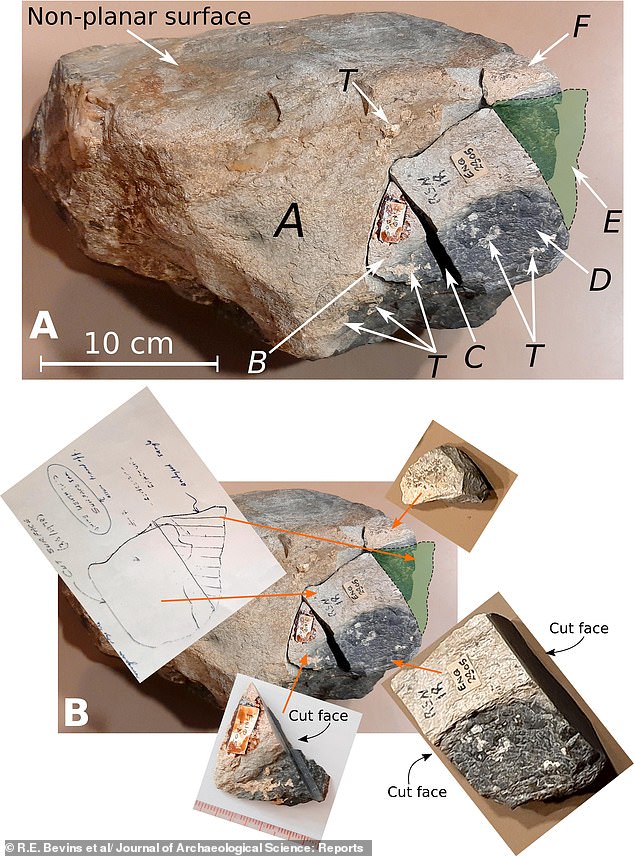
The main remaining part of the Newall boulder (Figure A) along with the part that has been detached for studies and analysis (Figure B)
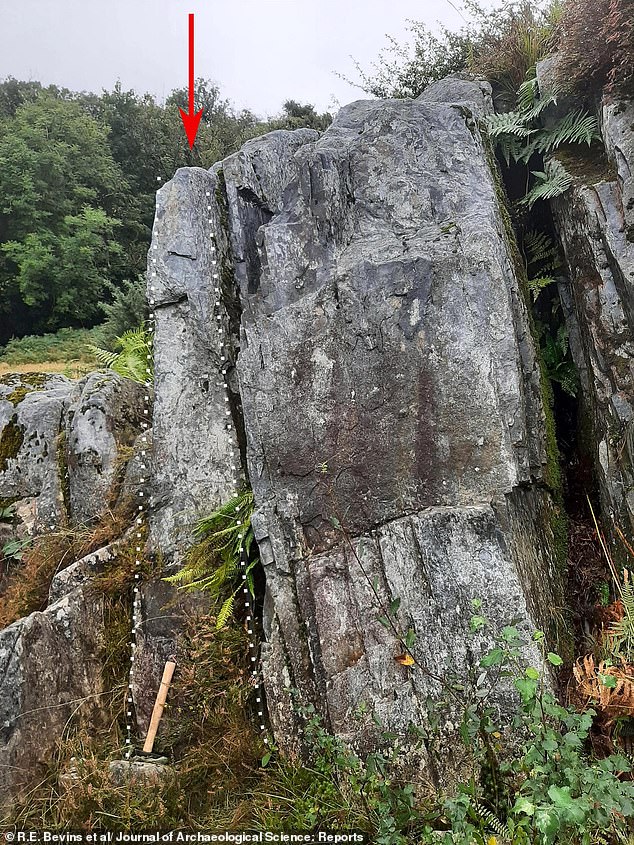
Columns of foliated rhyolite at Craig Rhos–y–Felin in north Pembrokeshire. The rounded tops of the columns are broadly ‘bullet shaped’, identical in form to the Newall boulder
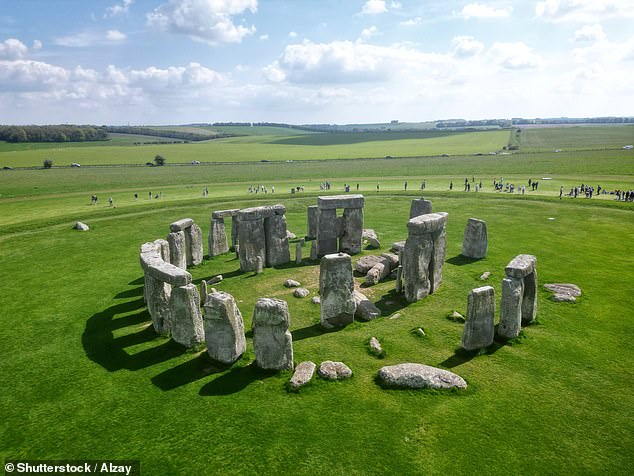
A drone view of Stonehenge and the Wilshire countryside. The stone circle is one of the best known ancient wonders of the world and a UNESCO World Heritage Site
There is already evidence of stone quarrying at the site, in north Pembrokeshire, by Neolithic communities around 3000 BCE, they explained.
Chemical analysis revealed that the Newall boulder and other fragments found at Stonehenge share identical levels of thorium and zirconium with the stone at Craig Rhos–y–Felin.
The researchers said the Newall boulder is a foliated rhyolite and has a surface layer rich in calcium carbonate – the result of its long burial in the chalky soils at Stonehenge.
This further reinforces the idea that it was brought here by humans and not glaciers, they said, because glaciers would have left a much more dispersed distribution of similar stones across the region – something that has not been found.
The study, published in the Journal of Archaeological Science: Reports, also makes an important discovery about another of the buried stones at Stonehenge – Stone 32d.
It was previously thought to be a type of rock called a spotted dolerite, but new analysis confirms it is also a foliated rhyolite – like the Newall boulder.
Transporting these stones, which can weigh over three tonnes, from Wales to Stonehenge would have been an incredible feat of human logistics.
‘Part of the fascination of Stonehenge is that many of its megaliths, in contrast to the large, relatively local sarsens, can be proven to have been sourced from Wales, over 200km to the west,’ the researchers wrote.
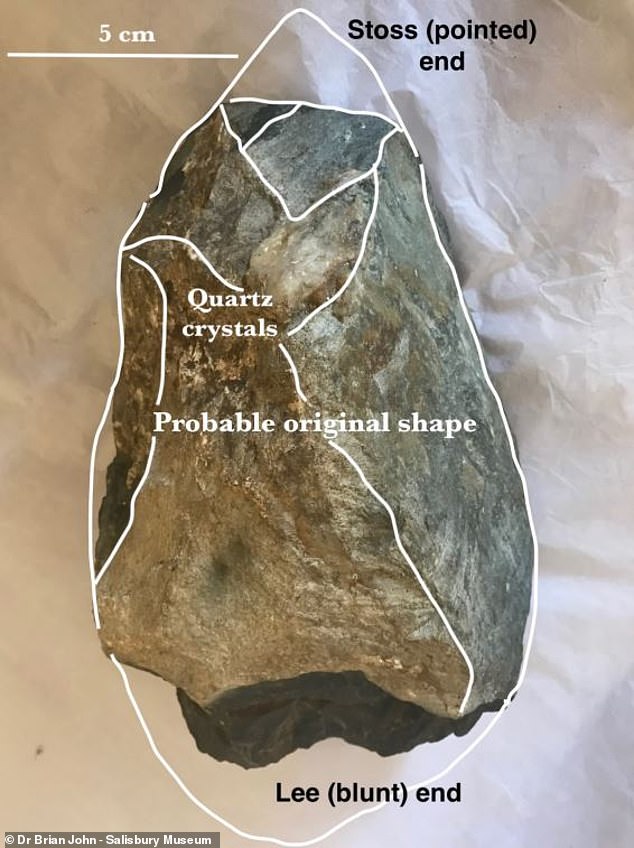
New research suggests the Newall Boulder (pictured) was transported by humans to Stonehenge from Wales
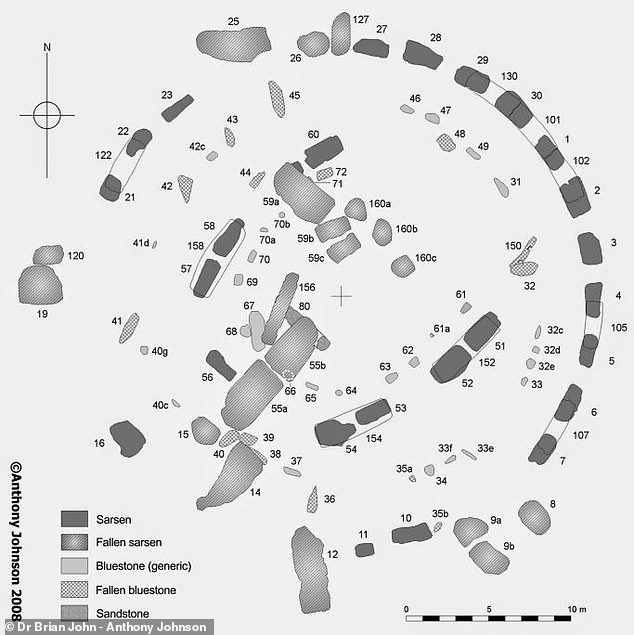
The findings suggest that the 80 or so bluestone boulders at Stonehenge may all have been carried to the site by by Neolithic builders
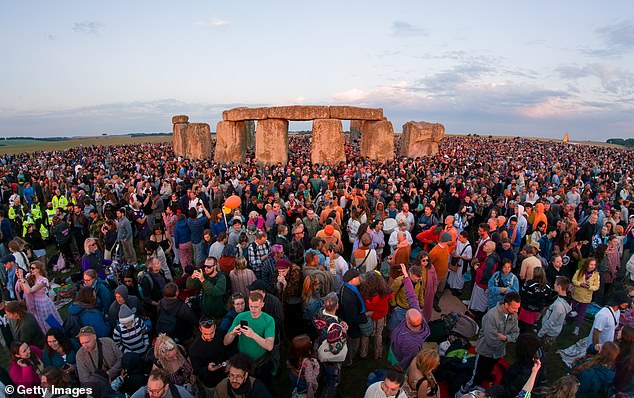
People have long been fascinated by Stonehenge due to its age, mystery, and impressive construction. Pictured: Visitors enjoy the sunrise during celebrations of the summer solstice at Stonehenge on June 21, 2025
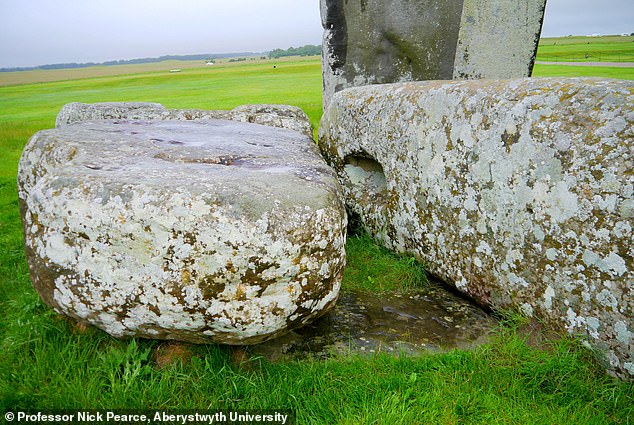
The reason why Stonehenge was built over 5,000 years ago remains one of archaeology’s most fascinating mysteries
‘Most archaeologists accept that Neolithic people achieved this remarkable feat, transporting blocks weighing up to 3.5 tonnes.
‘There is, however, a contrary view, which proposed that no human effort was involved.
‘Rather, it is argued, the Welsh stones were transported by glacial ice long before Stonehenge was built.’
One of the main proponents of the glacier theory is geologist Dr Brian John, who has previously insisted that the Newall boulder shows glacial abrasion marks.
A prior study of his concludes: ‘The boulder was reduced in size and heavily modified during glacial transport, for much of the time on the bed of a glacier.
‘It was eventually dumped at some location on, or relatively close to, Salisbury Plain.’
As part of the new study, the researchers said these features could also be the result of natural weathering.
They also said that even if the rock had been transported by ice in the past, it would not explain why similar fragments are only found at Stonehenge and not anywhere else on the Salisbury Plain.
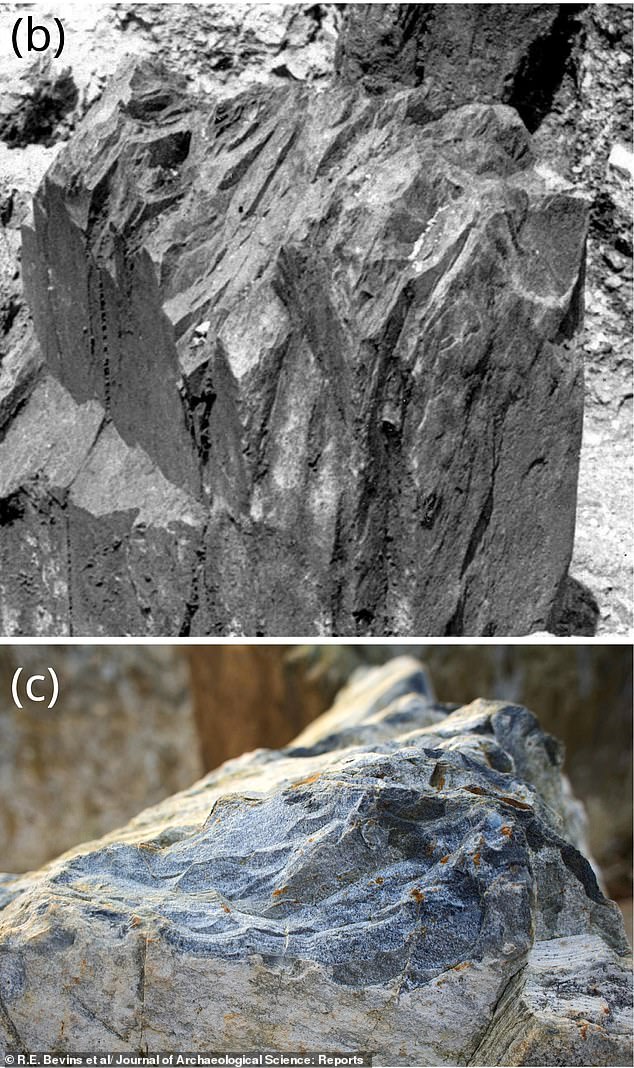
Experts say Stonehenge’s Stone 32D (figure B), as well as the Newall boulder, share identical levels of thorium and zirconium with the stones at Craig Rhos–y–Felin (figure C)
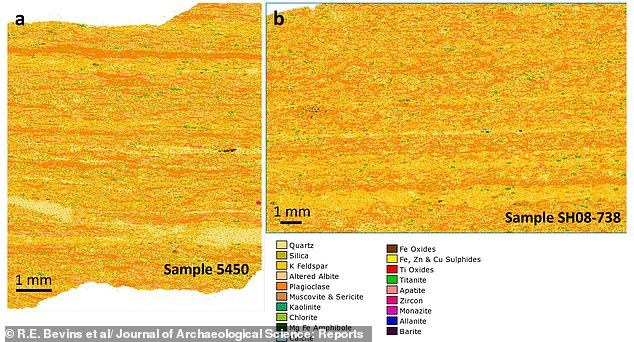
The experts said the minerologies of stone from Craig Rhos–y–Felin (left) are identical to stones from Stonehenge (right), indicating they came from the same source
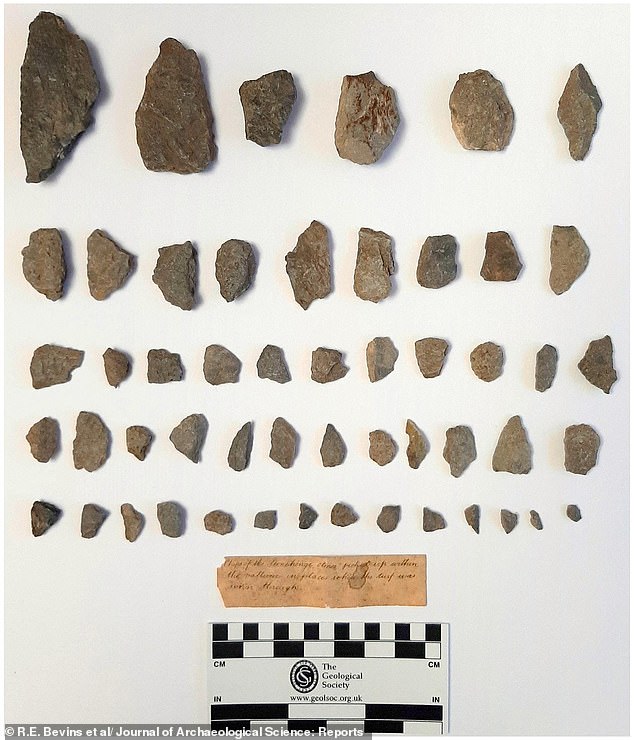
A typical collection of bluestone fragments collected from Stonehenge. The researchers said these are chipped fragments, not glacial erratics
Their findings indicate that Dr John’s arguments ‘have no basis in evidence’, they wrote, adding: ‘To present it as fact, rather than as hypothesis, is disingenuous’.
‘The presence of Stonehenge itself is the evidence of movement by Neolithic peoples of stones weighing up to as much as 40 tonnes,’ they wrote.
‘Unless it is argued that all the stones were just lying on the ground ready to be erected where they were to make Stonehenge, the stones must have been moved into position.
‘If Neolithic people could move a stone a few tens of metres they could move it tens or hundreds of kilometres.
‘It may not have been easy, but it was entirely possible and moving 2–3 tonne bluestones would involve an order of magnitude less effort than moving the sarsens.’
While the large sarsen stones were only transported from West Woods in Wiltshire – roughly 32km (20 miles) away – they weighed over 20 tonnes each and stood up to seven metres tall.
The famous ‘Altar Stone’ was even transported from Scotland around 750km (466 miles) away, a study published last year revealed.
‘There is no evidence for how they moved these stones,’ the researchers wrote, ‘but recent indigenous peoples have been transporting stones weighing many tonnes great distances with ropes, wooden sledges and trackways – technologies which would have been available in the Neolithic.’
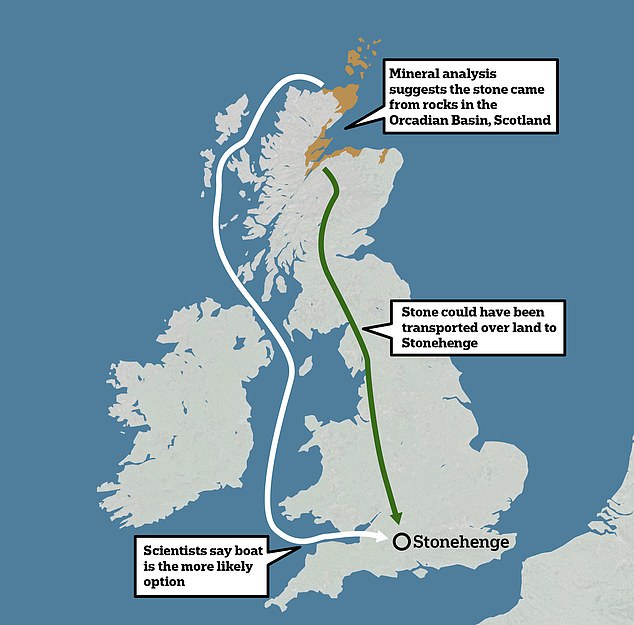
New analysis has revealed the Altar Stone, the largest bluestone at the centre of Stonehenge, actually came from northern Scotland – up to 1,000km (621 miles) away

The team said they can conclude with 95 per cent accuracy that the Altar stone (pictured here, underneath two bigger Sarsen stones) came from the area that encompasses parts of Inverness, Thurso, Orkney and parts of Shetland
While builders 5,000 years ago normally used whatever materials were at hand for stone circles, Stonehenge is ‘exceptional’ for being constructed entirely of stones brought from long distances, the team said.
Researchers have previously suggested that the site may have had a political as well as a religious purpose, ‘a moment of unification for the peoples of Britain, celebrating their eternal links with their ancestors and the cosmos’.
The new study provides strong evidence of human transport, but the mystery of exactly why Stonehenge was built – and how – is ongoing.
The team concluded: ‘We reiterate our previous interpretation that the Newall boulder is not a glacial erratic, that there is no evidence of glaciation on the Salisbury Plain, and that the bluestones were transported to Stonehenge by humans and not by ice.’

